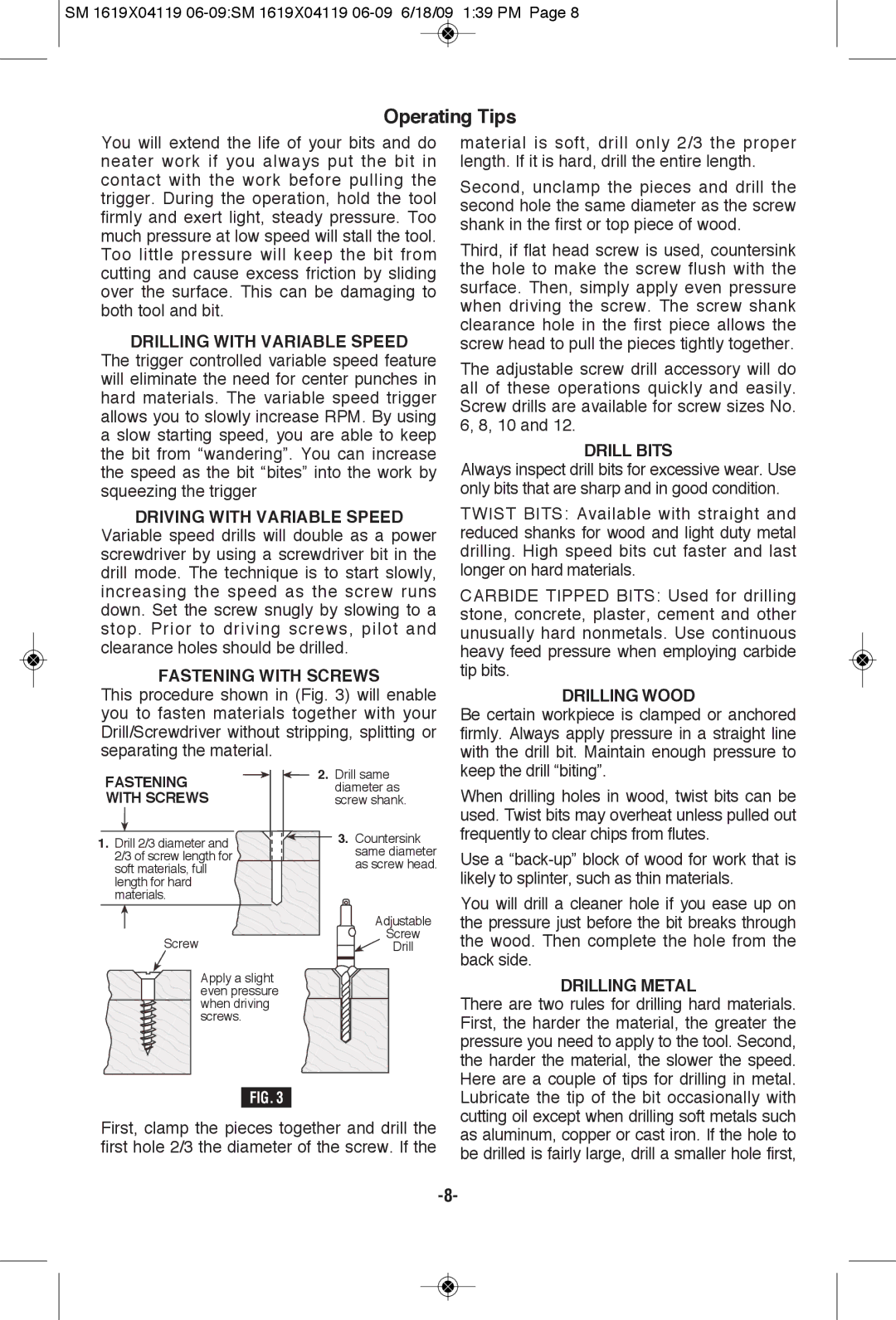
SM 1619X04119
Operating Tips
You will extend the life of your bits and do neater work if you always put the bit in contact with the work before pulling the trigger. During the oper ation, hold the tool firmly and exert light, steady pressure. Too much pressure at low speed will stall the tool. Too little pressure will keep the bit from cutting and cause excess friction by sliding over the surface. This can be damaging to both tool and bit.
DRILLING WITH VARIABLE SPEED
The trigger controlled variable speed feature will eliminate the need for center punches in hard materials. The variable speed trigger allows you to slowly increase RPM. By using a slow starting speed, you are able to keep the bit from “wander ng”i. You can increase the speed as the bit “bites” into the work by squeezing the trigger
DRIVING WITH VARIABLE SPEED
Variable speed drills will double as a power screwdriver by using a screwdriver bit in the drill mode. The technique is to start slowly, increasing the speed as the screw runs down. Set the screw snug yl by slowing to a stop. Prior to driving screws, pilot and clearance holes should be drilled.
FASTENING WITH SCREWS
This procedure shown in (Fig. 3) will enable you to fasten ma terials together with your Drill/Screwdriver without stripping, splitting or separating the material.
material is soft, drill only 2/3 the proper length. If it is hard, drill the entire length.
Second, unclamp the pieces and drill the second hole the same diameter as the screw shank in the first or top piece of wood.
Third, if flat head screw is used, countersink the hole to make the screw flush with the surface. Then, simply apply even pressure when driving the screw. The screw shank clearance hole in the first piece allows the screw head to pull the pieces tightly together.
The adjustable screw drill accessory will do all of these operations quickly and easily. Screw drills are available for screw sizes No. 6, 8, 10 and 12.
DRILL BITS
Always inspect drill bits for excessive wear. Use only bits that are sharp and in good condition.
TWIST BITS: Available with straight and reduced shanks for wood and light duty metal drilling. High speed bits cut faster and last longer on hard ma erialst.
CARBIDE TIPPED BITS: Used for drilling stone, con crete, plaster, cement and other unusually hard nonmetals. Use continuous heavy feed pres sure when employing carbide tip bits.
DRILLING WOOD
Be certain workpiece is clamped or anchored firm yl. Always apply pressure in a straight line with the drill bit. Maintain enough pressure to
FASTENING
WITH SCREWS
1. Drill 2/3 diameter and 2/3 of screw length for soft materials, full length for hard materials.
Screw
Apply a slight even pressure when driving screws.
2. Drill same diameter as screw shank.
3. Countersink same diameter as screw head.
Adjustable
Screw
Drill
keep the drill “biting”.
When drilling holes in wood, twist bits can be used. Twist bits may overheat unless pulled out frequently to clear chips from flutes.
Use a
You will drill a cleaner hole if you ease up on the pressure just before the bit breaks through the wood. Then complete the hole from the back side.
DRILLING METAL
There are two rules for drilling hard materials. First, the harder the material, the greater the pres sure you need to apply to the tool. Second, the harder the material, the slower the speed.
FIG. 3
First, clamp the pieces together and drill the first hole 2/3 the diameter of the screw. If the
Here are a couple of tips for drilling in metal. Lubri cate the tip of the bit occasionally with cutting oil except when drilling soft metals such as alu minum, cop per or cast iron. If the hole to be drilled is fairly large, drill a smaller hole first,
